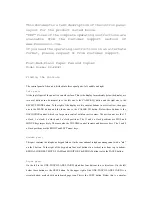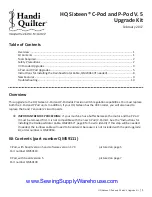
170 of 271
Harnesses
The replacement procedures are broken down for each individual harness. To retrieve the replacement
procedure, click on the appropriate link provided at the bottom of this page. To service any harness that
is not provided in this manual, contact Technical Support. Such harnesses are usually not a user or field
serviceable item.
Before attempting to replace a harness it is important that you first use the electrical troubleshooting
procedures provided in this manual to positively identify the harnesses as probable cause of the machine
failure. Replacing a harness represents a significant amount of work and might result in unneeded repair
costs if the wrong component is replaced (i.e., a harness rather than a motor, or sensor, etc). Harnesses
will generally be one of the last components in a particular circuit to fail. When they do fail, the usual
cause is likely to be due to handling during repair and maintenance procedures, especially not allowing
adequate slack when installing harnesses or letting harnesses contact moving parts. If harnesses are not
bundled with twist-lock cable ties or routed correctly, there is a possibility that they may rub against or
get caught in moving parts.
WARNING!!
Always turn the power off before disconnecting or connecting any harness. At the
minimum engage the emergency stop button by pressing in on the user interface.
CAUTION!!
As with any electrical component, always observe ESD safety procedures before
handling any internal electrical components.
CAUTION!!
Use extreme care not to drop metallic objects, tools, or other conductive material
on the Main PCB when you have the base cover removed. If you drop such objects on the Main
PCB, it can severely damage the electronics which will be very expensive to repair.
When a harness is replaced, always run a short functional test on the components affected by the indi-
vidual harness and run a test design (appropriate to the harness you replace) on the machine.
Always route the harnesses explicitly according to the instructions provided for installing each harness. If
you route a harness incorrectly, you might end up with too much slack remaining on the other end of the
harness or you might have a harness that seems to be too short. Always start the harness from the end
farthest away from the Main PCB (the end that connects to the applicable component such as a sensor
or a motor). Doing it this way will allow you to conceal extra slack in the harnesses inside the machine
base and away from any moving parts. Always securely tie the harnesses using twist-lock plastic cable
ties as specified in the installation instructions for each harness. Reuse the twist-lock cable ties when you
remove them from the harnesses.
Table of Contents
















































